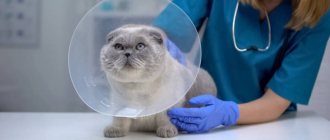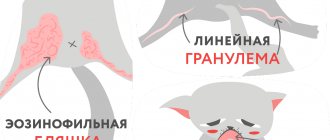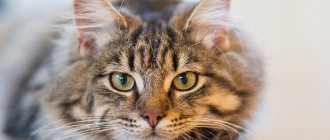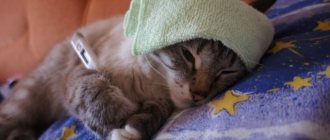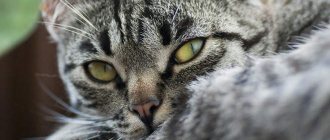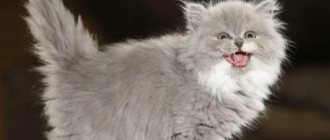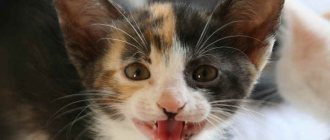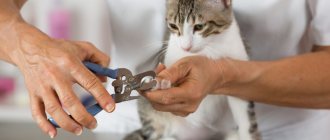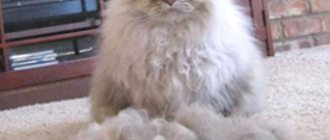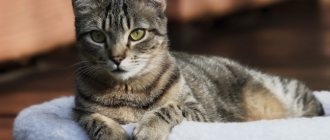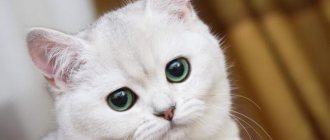Surprisingly, many owners may not even realize that their furry pets have weight problems. Often well-fed cats look very cute, and their special interest in food is easily justified by the fact that they simply love to eat.
However, excess weight sooner or later affects the health of the pet. To prevent this from happening, you need to know what signs indicate excess weight and what to do if your cat is obese. Specialists from a veterinary clinic in Moscow talk about everything in more detail.
Read in this article:
Common causes of obesity Signs of an overweight cat Why is obesity dangerous? Consequences of excess weight What to do if your cat is obese? Treatment of obesity in cats Useful tips to help your pet
Common Causes of Obesity
In 7 out of 10 cases, the cause of excess weight in a cat is overfeeding. An incorrectly selected diet, the animal’s constant access to food in violation of the daily norm (the average daily norm of dry food is from 25 to 55 g, depending on the pet’s weight), failure to maintain the balance of nutrients - all this can lead to obesity.
For example, giving your cat ready-made food is much more convenient, because it already contains a balance of proteins, fats, carbohydrates and fiber. However, many people prefer to feed their pet food specially prepared for it. Another issue is compliance with the daily nutritional intake. It is determined taking into account the weight of the animal and its physical activity - in each case individually.
On a note! The risk of gaining excess weight is more pronounced in Persian and British cats. Compared to other breeds, they are much more likely to experience obesity and the unpleasant consequences it leads to.
Other reasons that can cause obesity in a cat:
- Lack of physical activity . Many pets spend most of their lives in a house or apartment, so they cannot fully express their activity. On the one hand, the space for movement is limited, and on the other hand, the cat simply does not have a clear need to hunt or pursue prey. A common mistake that many owners make is to assume that the animal has already grown up, and therefore is simply not interested in games or other types of activity.
- Metabolic disease . Another common cause of obesity in pets. It is very difficult to recognize, so if your cat begins to gain weight for no reason, this may be due to improper metabolism in her body. Why is this happening? Most often, metabolic problems arise against the background of severe infectious diseases of the pet and diabetes mellitus. In any case, you should be careful and contact a veterinarian .
- Hormonal imbalances. Most often they occur due to improper functioning of the pancreas or thyroid gland, as well as due to disruption of the ovaries. In some cases, hormonal imbalances lead not only to weight gain, but also to other dangerous consequences. In this case, special attention should be paid to cats with non-insulin-dependent diabetes mellitus.
- Sterilization or castration. Obesity is common in castrated and sterilized cats. There are at least several reasons for this: metabolic disorders in the body (develop due to the removal or suppression of the functions of the testes and ovaries), changes in hormonal levels and improper nutrition of animals after castration or sterilization.
Refusal of food and water
If the cat does not eat after sterilization, there is no need to worry in the first days. She should not be forced to eat, but after two to three days, refusal to eat is a complication. If the cat is lethargic and does not eat, doctors recommend maintaining the pet’s strength through intravenous nutrition, or you can give liquid broth from a pipette or syringe. It also happens very often after surgery that the animal does not eat its usual foods, since the taste habit changes. For example, after surgery your cat doesn't eat her favorite fish, don't worry.
If, after sterilization, the cat refuses to drink and eat even on the second or third day, you should be wary. A particularly weak animal should generally be left in the clinic, where it will be given full care.
Signs of an overweight cat
The first thing you need to pay attention to is the weight. For cats, there is no universal standard by which one can say whether a pet is now normal weight or overweight. These indicators are determined depending on the breed of the animal and its age.
For convenience, you can use this table to check if your cat is obese:
| Animal age | Outbred | British breed | Maine Coon | |||
| cat | cat | cat | cat | cat | cat | |
| 4 months | 2.3-3.2 kg | 2.2-2.8 kg | 2.1-3.9 kg | 1.7-2.5 kg | 3-3.8 kg | 2.7-3.6 kg |
| 10 months | 3.1-4.4 kg | 2.4-4 kg | 4.1-6.7 kg | 2.8-4.4 kg | 4.8-7.2 kg | 4.3-6.5 kg |
| 1 year | 3.5-5 kg | 3.5-4.5 kg | 4.5-7 kg | 3.1-4.6 kg | 5.4-8.8 kg | 4.5-8.3 kg |
*The data indicated in the table is indicative. When determining normal weight, it is important to take into account not only breed and age, but also the level of physical activity. Exceeding the specified data by 15-20% is the norm. In any case, it is worth contacting a professional veterinarian in Moscow to determine what weight is normal for your pet and what is excessive.
Other signs that indicate your cat is obese:
- Can't feel the ribs.
If your pet is of normal weight, then the contours of the ribs are easy to feel. Try it now. Carefully feel the ribs, and if this is difficult to do or is not possible at all, then this directly indicates that the animal is overweight.
- It is not noticeable how the pet breathes.
Breathing in a cat that is overweight is almost imperceptible. Another thing is an animal with normal weight. If it lies on its side, you will be able to see all the breathing movements (inhalation, exhalation).
- Waddle".
A waddling gait is another sign of obesity (unless your cat is pregnant or sick). Watch how your pet walks. Does it shift from paw to paw? If yes, then this is a reason to be wary and consult a veterinarian.
Peritonitis
Why does the kitten have a big belly, but he himself is thin? One of the most dangerous problems that causes bloating is ascites. In this case, the kitten suffers from the accumulation of fluid in the abdominal cavity. Peritonitis is very dangerous and requires immediate medical intervention.
What to do if a kitten has What to do? It is necessary to determine whether the pet actually has ascites. To do this, it is recommended to pick him up and hold him in an upright position for a while. If the animal’s figure resembles a pear (which occurs as a result of liquid flowing down), and after lowering the kitten’s belly again looks like a ball, then there can be no doubt. Therefore, do not hesitate, go to the doctor.
Why is obesity dangerous? Consequences of excess weight
Unfortunately, fat cats are not only cute. Excess weight in pets negatively affects almost all internal organs and systems. One of the common consequences that extra pounds lead to is diabetes. According to statistics, it is diagnosed 3.7 times more often in obese cats than in pets of normal weight.
Other consequences that may occur due to excess weight:
- diseases of the musculoskeletal system (the bones, joints and muscles of the animal are not designed for excess loads, which are constantly present in obesity);
- increased blood pressure;
- high risk of cardiovascular diseases (for example, heart failure);
- metabolic disorders;
- development of urolithiasis;
- digestive system disorders, etc.
All this leaves an imprint on the quality of life of your cat, so it is very important to take care of its health in a timely manner and contact a veterinary clinic.
Diagnostics
Diagnosis of manifestations involves a number of procedures, such as ultrasound of internal organs.
Even two or three pathological signs should be a reason to immediately take your four-legged friend to see a doctor. During the initial examination, the veterinarian will try to find out the main reasons why the cat’s belly hangs. To determine the diagnosis and prescribe adequate treatment, a referral is given to undergo a number of such diagnostic procedures:
- general clinical analysis of blood and urine;
- biochemistry;
- puncture and histological examination of the contents of the sac;
- Ultrasound of internal organs.
What to do if your cat is obese?
If you find your furry pet is overweight, the first thing to do is consult a veterinarian. A cat should only lose weight under the supervision of a specialist. In most cases, 1-2 visits to the veterinarian are enough for him to determine the cause of obesity, find out what weight is normal for a pet, and also give recommendations on a healthy diet.
On a note! If a specialist diagnoses obesity, he will prescribe the correct treatment. It is compiled taking into account the general health of your pet.
Lethargy and drowsiness
Sterilization occurs under general anesthesia, so symptoms such as apathy, lethargy, and drowsiness are normal. Some individuals may remain in this state almost until the moment when it is necessary to remove the sutures. In addition to the fact that she is lethargic, the pet does not eat or drink - it all depends on how the cat’s body is structured. If she is still lethargic, sleeps a lot and does not eat or drink anything after two weeks after the operation, you need to contact a veterinarian.
How the cat behaves after the operation, see further in the video.
Treatment of obesity in cats
Treatment options for obesity in cats:
- Diet correction . In one case, the veterinarian completely changes the animal’s diet, in another he may limit himself to only its correction - this is always individual. The diet is adjusted in different ways: the volume of feed , special nutrition , and the optimal feeding regimen .
- Diet . It is based on several principles at once: reducing the amount of fats and carbohydrates, increasing the amount of fiber and protein. It is important to increase your water consumption. Many veterinarians recommend placing water bowls in every room. It is recommended to change the water daily to keep it as clean and fresh as possible.
- Physical activity . Gaining extra pounds always indicates that your pet is taking in many more calories than it can burn. “Excess” calories can be removed not only by reducing the amount of feed, but also by additional physical activity. Set aside 15-30 minutes a day to play with your pet and choose new toys for him.
If obesity occurs due to diseases or hormonal disorders, then a comprehensive examination of the animal’s health is necessary. This will allow you to identify the exact cause of excess weight and ensure its effective elimination. In any case, you should stop self-medicating and consult a veterinarian to be sure of your pet’s health.
Changes in muscle tone during pregnancy
In most cases, pregnancy in cats is easy. The cat does not feel any discomfort, but is reluctant to be handled and strains its abdominal muscles when trying to feel it. A very hard belly in a cat may indicate a pathologically developing pregnancy. This condition ends in miscarriage and is accompanied by changes in the pet’s behavior - she refuses to eat, drinks a lot, behaves restlessly and constantly meows.
If your cat has a hard belly after giving birth, you should take the animal to the vet as soon as possible. This is a dangerous sign indicating the development of pyometra. This disease is caused by the penetration of pathogenic bacteria into the uterine cavity. Pyometra is accompanied by profuse suppuration, which can be caused by infection of the uterus during delivery.
Symptoms of a dangerous disease:
- Hard and swollen abdomen.
- Refusal of food.
- Increased thirst.
- Increased body temperature.
- General deterioration in health.
With pyometra, veterinarians insist on surgical removal of the uterus and appendages. A timely detected disease can be successfully treated with antibiotics, but only at the beginning of the development of the pathological process.
Useful tips to help your pet
You should not expect that after starting treatment your cat will quickly acquire ideal shape. The weight will not go away quickly, since due to their physiological characteristics, furry pets cannot starve. You will notice the first results no earlier than in 2-3 weeks, but in the meantime, pay attention to several useful recommendations:
- Your cat's weight loss should be smooth and, most importantly, healthy. By sharply limiting the amount of food she consumes, it will not be possible to achieve any result other than the development of associated negative consequences for the entire body;
- The optimal norm for domestic cats is to reduce body weight by no more than 1% per week. Otherwise, intensive weight loss can trigger the onset of diabetes;
- Avoid any questionable treatments, including dietary supplements used to control your appetite. Even if friends, colleagues, or relatives recommend them to you, you should not risk the health of your beloved animal;
- Do not alternate between natural food and professional commercial food. Choose one thing - what you will feed your cat on an ongoing basis. It is best to immediately coordinate all issues with your veterinarian;
- Do not give your pet treats from your table. Smoked, fried, sweet - all this is categorically not recommended. By the way, this rule applies not only to animals facing obesity, but also to those whose weight is within the normal range;
- Your good helpers are interactive toys. Playing mazes for cats, winding mice and other game options help the cat fight extra pounds with pleasure, since they require additional physical activity from her.
If you consult a veterinarian and follow these simple recommendations, then be sure that after a while your cat’s figure will be truly “exemplary”, and the dangerous consequences that arise from being overweight will be avoided!
Symptoms characteristic of gastric diseases
In addition to general signs of malaise, stomach diseases are accompanied by specific symptoms:
- regular vomiting after eating;
- Diarrhea is more common, but constipation is also possible;
- gray coating on the tongue;
- When you feel the abdomen, tension is felt, the animal experiences obvious discomfort.
In advanced cases of the disease, dangerous conditions may develop, such as gastric bleeding. Symptoms of bleeding in a cat's stomach depend on its intensity. Small streaks of blood in the vomit, as a rule, do not pose a danger, since they appear during intense vomiting due to rupture of the capillaries of the esophagus.
Prolonged bleeding is characterized by the accumulation of blood in the stomach. When in contact with gastric juice, it coagulates, turning into a brown mass, so vomiting “coffee grounds” is considered a very alarming symptom of stomach disease in a cat. Copious discharge of scarlet blood indicates severe bleeding and requires urgent surgical intervention.
The cat has a hard belly
